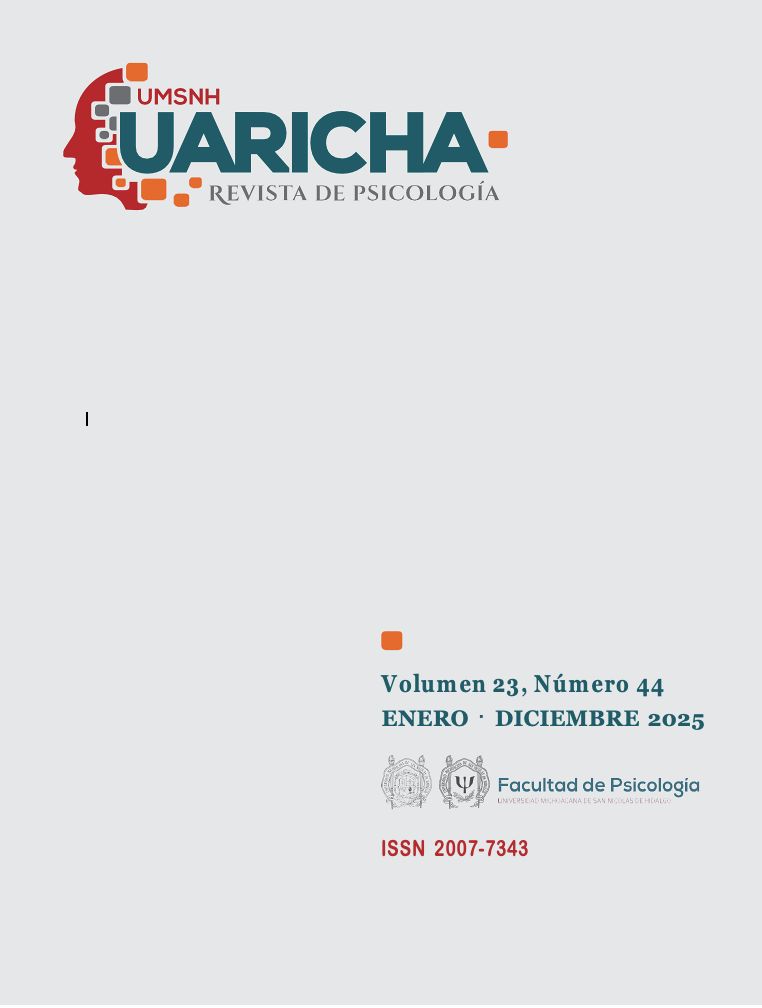Assessing grief in students after the loss of a loved one due to COVID-19
Main Article Content
Abstract
Grief is a natural process that arises after the loss of a loved one and that can manifest itself in different ways and intensities, depending on internal and external factors that can influence the personal development of those who experience it. In the context of the COVID-19 pandemic, a significant part of the population had to face the loss of a loved one in the midst of circumstances marked by social isolation, uncertainty and limitation of social and emotional resources, which could influence their grieving process. In this sense, the objective of the study was to evaluate grief in students who have lost a loved one due to COVID-19. The research has a quantitative methodology, a non-experimental design, a descriptive scope and is cross-sectional; The Revised Texas Inventory of Grief (ITRD) was applied to 33 students (x = 21.24, SD = 1.85) from the UMSNH. The main results showed that the majority of participants (75.75%) experienced prolonged grief, 15.15% delayed, 3.03% absent, and 9.09% did not experience grief. These findings highlight the prevalence of prolonged grief in students, as well as the existence of variability in emotional responses to grief, which suggests the need for specialized support to help them adequately cope with this process.
Article Details
Issue
Section

This work is licensed under a Creative Commons Attribution-NonCommercial-NoDerivatives 4.0 International License.
The authors have the right to ownership or copyright and they give to "Uaricha Psychology Magazine" the right to publish for the first time the article, as well as disclose and distribute it on the technological available media and through repositories.
Uaricha Psychology Magazine, is a quarterly publication, published by the Psychology College of the "Universidad Michoacana de San Nicolás de Hidalgo", Street Francisco Villa No. 450, Col. Dr. Miguel Silva, Morelia, Michoacán, P. C. 58110. Phone (+52) 443 312 9909, ext. 149, www.revistauaricha.umich.mx, uaricha.publicaciones@umich.mx. Responsible publisher: Roberto Oropeza Tena. Reserve of exclusive use rights No. 04-2013-070413365500-203, e-ISSN: 2007-7343, Granted by the National Institute Copyright. Responsible of the last update of this number, Computer center of the Psychology College, Ing. Erick Vidar Alva Rangel.
How to Cite
References
American Psychological Association. (2020). COVID-19 and Mental Health: Coping with Grief and Loss. https://www.apa.org/ethics/code
Balk, D. E., & Corr, C. A. (2009). Adolescent encounters with death, bereavement, and coping. Springer Publishing Company.
Centers for Disease Control and Prevention. (2021). Children & Teens and COVID-19. https://www.cdc.gov/
Currier, J. M., Holland, J. M., & Neimeyer, R. A. (2006). Sense-making, grief, and the experience of violent loss: Toward a mediational model. Death Studies, 30(5), 403-428. https://doi.org/10.1080/07481180600614351
Eisma, M. C., Tamminga, A., Smid, G. E., & Boelen, P. A. (2020). Acute grief after deaths due to COVID-19, natural causes and unnatural causes: An empirical comparison. Journal of Affective Disorders, 278, 54-56. https://doi.org/10.1016/j.jad.2020.09.049
Faschingbauer TR. (1981). Texas Revised Inventory of Grief manual. Houston: Honeycomb Publishing.
Faschingbauer, T., Zisook, S., & DeVaul, R. (1987). The Texas Revised Inventory of Grief. In S. Zisook (Ed.), Biopsychosocial aspects of bereavement (pp.111-124). Washington, DC: American Psychiatric Press.
Kessler, R. C., & Denes, A. (2020). Mourning and Grief During the COVID-19 Pandemic. JAMA, 324(18), 1830-1835. https://www.sciencedirect.com/
Jeffreys, J. S. (2005). Coping with childhood bereavement. Routledge.
Lobb, E. A., Kristjanson, L. J., Aoun, S. M., Monterosso, L., Halkett, G. K., & Davies, A. (2010). Predictors of complicated grief: A systematic review of empirical studies. Death Studies, 34(8), 673-698. https://doi.org/10.1080/07481187.2010.496686
Neimeyer, R. A., Harris, D. L., Winokuer, H. R., & Thornton, G. F. (Eds.). (2014). Grief and bereavement in contemporary society: Bridging research and practice.
Routledge.Servaty-Seib, H. L., & Pistole, M. C. (2006). Adolescent grief: Relationship category and emotional closeness. Omega, 54(2), 147-167. https://doi.org/10.2190/4Q6W-V6X7-6R52-L751.
Secretaría de Salud. (2024). Coronavirus (COVID-19). https://coronavirus.gob.mx/
Stroebe, M., & Schut, H. (1999). The dual process model of coping with bereavement: Rationale and description. Death Studies, 23(3), 197-224. https://doi.org/10.1080/074811899201046.
Stroebe, M., Schut, H., & Stroebe, W. (2007). Health outcomes of bereavement. The Lancet, 370(9603), 1960-1973. https://doi.org/10.1016/S0140-6736(07)61816-9.
Stroebe, M., Stroebe, W., & Schut, H. (2001). Gender differences in adjustment to bereavement: An empirical and theoretical review. Review of General Psychology, 5(1), 62-83. https://doi.org/10.1037/1089-2680.5.1.62
Worden, J. W. (2018). Grief and Loss: Counseling and Practical Support for Caregivers. Routledge. https://www.routledge.com/Series-in-Death-Dying-and-Bereavement/book-series/SE0620.
Worden, J. W., & Davies, B. (1983). Mourning and the resolution of grief. In J. E. Schowalter, R. Patterson, A. H. Kutscher, R. D. Videka-Sherman, & D. L. Jones (Eds.), The child and death (pp. 37-50). Charles C. Thomas.

